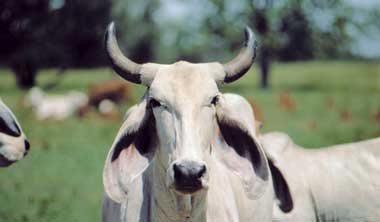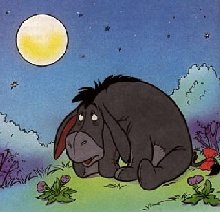CRUELTY TO ANIMALS USED TO MAKE
LEATHER
HOLY "COW" URGES END TO CATTLE
ABUSE

For more information on PETA’s Indian Leather Campaign, please visit our
Web site www.PETAIndia.com. Copies
of PETA’s exposé into the Indian leather trade are available, as are
copies of Paul McCartney’s, Crispian Mills’ and Arun Gandhi’s letters.
PETA Targets Cruel Transport of Animals Killed in Leather Trade
For Immediate Release: April 15, 2000
Contact: Jason Baker 98201 22602
Bangalore –– Holding a sign reading "Stop Cruel Cattle
Transport––Don’t Buy Leather", and handing out chilis, like those
that are smeared into the eyes of cows who have collapsed en route to slaughter,
a "cow" will urge Bangalore residents to oppose the abuse of cows by refusing
to buy leather:
Cows were once held sacred in India, but demand for cheap leather has
spawned a grotesquely cruel underground industry. Because it is illegal to
slaughter cows in most of the country, corrupt skin-traders use bribes to
smuggle the animals at night across state borders. The cows and calves, who
are bought under the pretense that they’ll live out their lives on rural
farms, are instead marched for days to slaughter in direct violation of the
Constitution of India. Those who collapse have chili peppers and tobacco
rubbed into their eyes and their tails broken in an effort to keep them
moving.
The Indian leather trade has become the target of animal activists around
the world who agree with Mahatma Gandhi’s belief that "The greatness of a
nation and its moral progress can be judged by the way it treats its animals".
In addition, PETA’s campaign to expose the horrific conditions that Indian
cattle are kept in during transport has drawn the attention and support of
numerous celebrities.
Superstar Pamela Anderson Lee appears in PETA’s video of the Indian leather
trade, shot during visits by PETA’s president, Ingrid Newkirk, to Tamul Nadu,
Kerala, Mumbai and other states. Rocker Chrissie Hynde of the Pretenders
turned her latest concert tour into a protest tour, demonstrating outside
of stores that purchase Indian leather. Hynde was arrested in New York after
climbing into the display window of a store and destroying jackets made from
Indian cows.
Former Beatle Sir Paul McCartney has written to the Indian Prime Minister,
asking for protection for these animals, as has Arun Gandhi, grandson of
Mahatma Gandhi, urging the prime minister to enforce existing laws that would
protect the cows. Musician Crispian Mills of Kula Shaker also sent a letter
to the prime minister saying, "Without animal protection, the principle of
dharma is in a state of collapse".
Animal-free "leather", called "pleather", is growing rapidly in popularity
overseas and has become a major trend in the United States and Europe. Many
celebrities, including Woody Harrelson, Drew Barrymore and Alicia Silverstone,
are setting stylish and compassionate trends by choosing synthetic materials
over real animal skins. Famous designers, including Todd Oldham and Stella
McCartney, use "pleather" instead of cow skin, and animal-free synthetics
are becoming available everywhere, from the most expensive boutiques to discount
shoe outlets.
Buying leather directly supports the misery of the slaughterhouse. Statistics
from the Ministry of Food Processing Industries and the Council for Leather
Exports conclude the value of leather exports from India is 10 times more
than the value of its meat exports, and with India as the largest leather
manufacturer in the world, cows, buffaloes, and other animals suffer cruel
slaughter just for their skins.
Believe it or not, India's treatment of cows and cattle is among the
cruelest in the world. Since it is illegal to kill healthy, young cattle,
they are often deliberately maimed. Their legs are often broken or they are
poisoned so that they can be declared fit for slaughter.
Cattle are tied together with ropes through their pierced noses and beaten
mercilessly in forced "death marches" over hundreds of kilometres and transported
in appalling conditions, crammed on top of each other into lorries in the
searing Indian heat. They trample one another and suffer and die from suffocation
and horn gouges. The lorries careen across the kilometers on bumpy dirt and
gravel roads and mountain passes, pitching the cows around and causing more
injury and death.
During the marches, cattle collapse from hunger, exhaustion, injury and
despair. Handlers force them along by snapping their tails at each joint
and rubbing tobacco, chilies and salt into their eyes. Each snap brings pain
analogous to that of breaking a finger. They are never offered food or even
as much as a drop of water.
By the time they arrive at the slaughterhouse, some are dead and many
are so sick and injured that they must be dragged inside. A closer look at
the animals still conscious reveals sheer terror, indicated by their fur
standing on end. Once inside, their throats are slit in front of their
companions. Some have their legs hacked off whil estill conscious or suffer
the agony of being skinned alive.
Update: April, 2000:
GAP announces a ban on using Indian and Chinese leather
"While the cows were being loaded, I could hear the gurgling of one cow
choking on her own blood. The rope in her nose had been improperly placed,
and with the constant tugging on it by rough handlers, as well as being tethered
to her fellow cattle during the 12-hour march, it had ripped through her
nose, and blood was pouring down her face".
—PETA investigator
The Role of the Dairy Business
A common source of hide for ahinsak footwear is dairies! Since male calves
are of no use to dairy owners, some are sold for slaughter, while others
are intentionally starved to death so that their skin can be sold to ahinsak
manufacturers.
Milk is not necessary in a balanced diet:
In a recent Times of India article by Vijaya Venka entitled, "Go Natural:
The Myth of Milk", the health benefits appear to be no better than the cruelty
involved in the dairy industry.
Now, it seems that milk can also cause Crohn's disease, which claims
up to 3,000 victims a year in the UK alone. The main symptoms include tiredness,
urgent diarrhea, loss of weight, etc., which are often misdiagnosed as
psychosomatic manifestations. Crohn's disease causes inflammation, deep ulcers
and scarring of the intestine.
Cattle Are Not the Only Animals Killed for Their Skins
While most leather products are made from the skins of cattle and calves,
leather is also made from the skins of horses, sheep, lambs, goats and pigs
who are slaughtered for meat. Most of these animals suffer the horrors of
factory farming—overcrowding, unanesthetized castration, branding,
tail-docking and dehorning. Other species are hunted and killed specifically
for their skins, including zebras, bison, boars, deer, kangaroos, elephants,
eels, sharks, dolphins, seals, walruses, frogs, crocodiles, lizards and snakes.
Rats, cats and stray dogs are also killed for leather, but since people are
typically put off by this fact, it is passed off as simply "leather". Much
of the leather sold as "crocodile" and other wildlife items are actually
made from endangered, illegally poached animals. When you buy leather, you
can’t tell what animal it was made from.
"Exotic" animals such as alligators are factory farmed for their skins.
Ranched alligators are kept in tiny structures, with up to 600 inhabiting
one building, which reek of rancid meat, alligator waste and stagnant water.
Although alligators may naturally live up to 60 years, on farms they are
usually butchered before their fourth birthday.
Alligators on farms are often beaten with hammers and sometimes take
up to two hours to die. Snakes and lizards are often skinned alive because
of the widespread belief that live flaying imparts suppleness to the finished
leather. Kid goats may be boiled alive to make kid gloves, and the skins
of unborn calves and lambs—some purposely aborted, others from slaughtered
pregnant cows and ewes—are considered especially "luxurious".
According to recent international press reports, in one province in Thailand,
dogs are rounded up and crushed, more than 50 at a time, into a lorry for
five days without food or water, only to become "briefcases, car seat covers,
trimmings on a fancy coat or ironically, fancy rawhide chews for pampered
"pet" dogs".
Each month, 30,000 dogs suffer the same fate, with their hides being exported
internationally. The consumer is largely unaware of these products' origin,
as the seller uses cover labels such as "lamb", "calf" or "goatskin". The
labels will never say "dog"; however, it is not technically illegal to sell
or import dog fur, even in the European Union.
Tannery Toxins
Leather factories wreak havoc on the environment. The leather tanneries
around the Ganges have been cited for dumping toxic metals such as chromium
into the river. All wastes containing chromium are considered hazardous.
Tannery effluent also contains large amounts of other pollutants, such as
protein, hair, salt, lime, sludge, sulfides and acids. Groundwater near tanneries
has been found with highly elevated levels of lead, cyanide and
formaldehyde.
People who work in tanneries and live near them are dying of illnesses
caused by constant exposure to such toxic chemicals. Pollution such as that
dumped into the Ganges by surrounding leather tanneries has been cited as
one major reason for outbreaks of illnesses as well as death of marine life.
The U.S. Centers for Disease Control and Prevention found that the incidence
of leukemia among residents near one tannery was five times the U.S.
average.
Environmentalists and Citizens Protest Tannery Toxins
On March 13, environmental activists and villagers in Kanpur, home of
the largest tanneries in India, banded together and blocked a tannery drain
that releases toxic effluent into the Ganges River.
The protest stems from the fact that the effluent from leather tanneries,
although polluted with chromium and other chemicals used in the tanning process,
is being promoted as "treated" and safe for irrigation of farmland. But the
polluted water has laid waste to crops and is rendering the soil infertile.
Villagers who are exposed to the "treated" water also complain of itching
and raw skin, numbness, and paralysis. Livestock who drink the water are
also suffering adverse effects. Environmentalists fear that the toxins from
the tannery effluent are being passed along the food chain through the exposed
crops and report that some villagers are already showing signs of
poisoning.
Leather Alternatives
It’s easy to find inexpensive quality shoes and accessories that are
stylish and free of animal suffering. Just about anywhere you shop you can
find a wide selection of nonleather jackets, shoes and accessories made from
materials such as cotton, linen, ramie, canvas and synthetics. |



